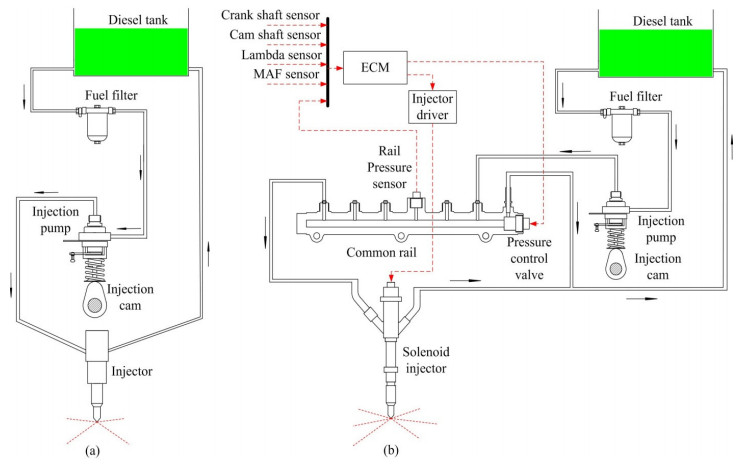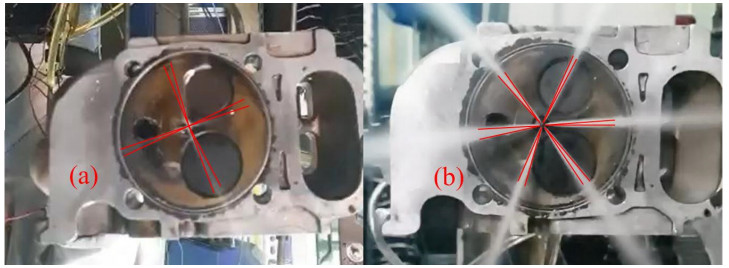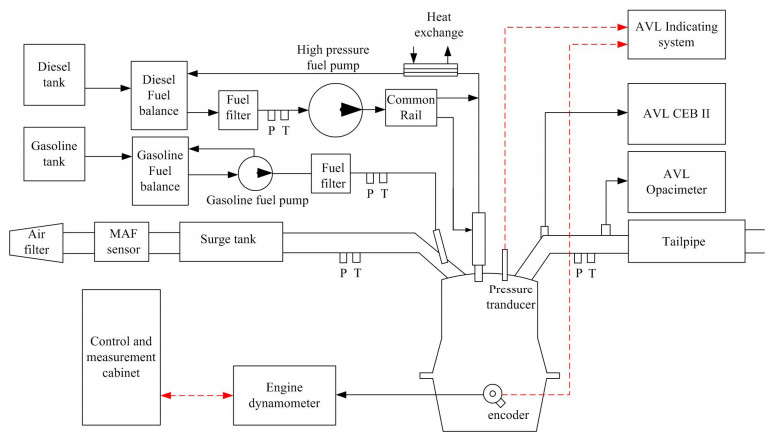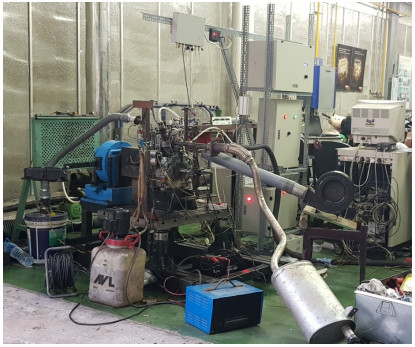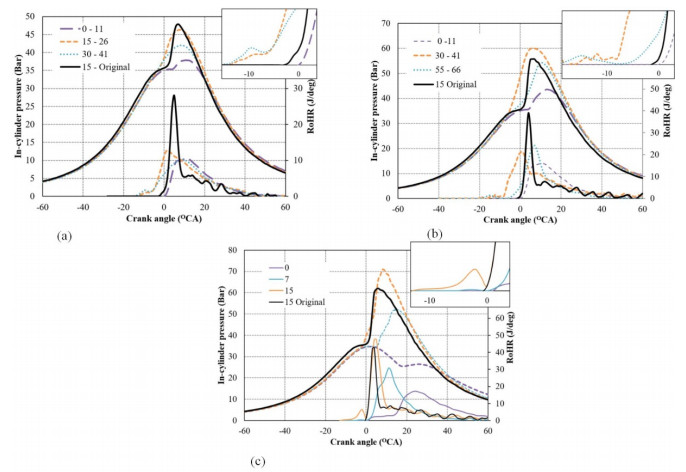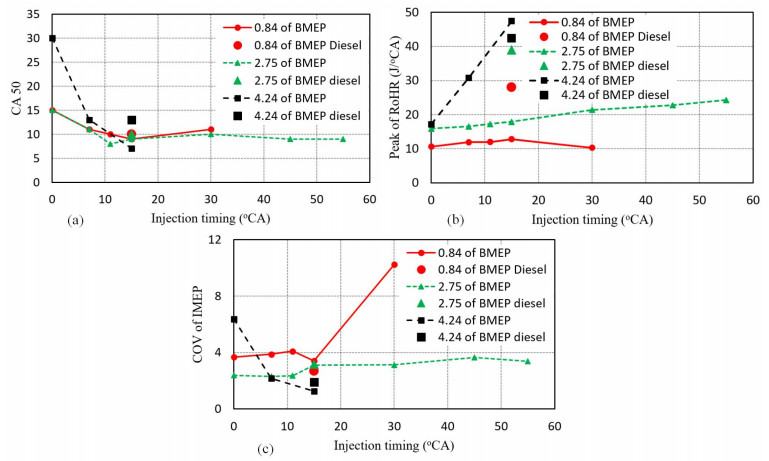This study explored methods to evaluate the test engine characteristics operated based on the reactivity controlled compression ignition (RCCI) technology to reduce fuel consumption and exhaust emissions, especially PM and NOx. Consequently, gasoline and diesel, respectively, considered as the low reactivity fuel (LRF) and high reactivity fuel (HRF), are injected in the intake manifold and combustion chamber. The experimental procedure is conducted at a constant speed of 2000 rpm, and brake mean effective pressure (BMEP) from low load 0.84 bar to high load 4.24 bar. The injection strategy is varied according to the engine loads. Indeed, at the low and medium engine load condition, the diesel fuel is injected double injection pulse, at the high load, the diesel fuel is injected single injection pulse. The injection timing is advanced from the top dead center (TDC) until knocking happens or the coefficient of variation (COV) higher than 10%, and maximum advanced injection timing is 65 crank angle degree (℃A) before the top dead center (BTDC). The results of advanced injection timing show that limit of advanced timing in low load is COV while at high load is knocking; at medium load, the diesel injection timing can be advanced to 65℃A BTDC. The exhaust emissions of CO and HC are higher than conventional diesel engines, while soot is hugely lower in all operating points. NOx emission is much dependent on injection timing, at 10 to 20℃A BTDC NOx highest, and approximately to the conventional diesel engine, NOx reduction when injection timing advanced.
Abbreviations: ATDC: After top dead centre; BTDC: Before top dead centre; BMEP: Brake mean effective pressure; BP: Brake power; BSCO: Brake specific carbon monoxide; BSFC: Brake specific fuel consumption; BSHC: Brake specific hydrocarbon; BSNO: Brake specific nitric oxide; BTE: Brake thermal efficiency; CAD: Crank angle degree; CA50: Crank angle at which 50% of energy release; CEB II: Combustion emission bench II; CO: Carbon monoxide; CO2: Carbon dioxide; COV: Coefficient of variation; CRa: Compression ratio; CR: Common rail; DI: Direct injection; DPF: Diesel particulate filter; EGR: Exhaust gas recirculation; EVC: Exhaust valve close; EVO: Exhaust valve open; FSN: Filter smoke number; FSN: Filter smoke number; HC: Hydrocarbon; HCCI: Homogeneous charge compression ignition; HFM: Hot film mass air flow sensor; IMEP: Indicated mean effective pressure; ICE: Internal combustion engine; IVC: Intake valve close; IVO: Intake valve open; LTC: Low temperature combustion; NO: Nitric oxide; NOx: Oxides of nitrogen; ON: Octane number; PCCI: Premixed charge compression ignition; PPC: Partially premixed combustion; PM: Particulate matter; RCCI: Reactivity controlled compression ignition; RoHR: Rate of heat release; RoPR: Rate of pressure rise; Rpm: Revolution per minute; SI: Spark ignition; SoC: Start of combustion; SoI: Start of injection; TDC: Top dead centre
1.
Introduction
Internal combustion engines have been the primary power source for transportation, industrial agriculture since the last century [1]. However, the main problem of ICEs is related to fuel price and environmental pollution, and thus it is essential to find out the solution for enhancing the ICEs' efficiency. Typically, the compression ignition engine is more economical than the spark ignition engine because of its higher compression ratio and lower throttle losses under partial-loads. Notwithstanding, there are some problems related to the stratified mixture, high-temperature in-cylinder, and high-pressure in-cylinder; they are the reason for higher NOx and soot emissions of diesel engines compared to SI engines. Although soot emissions can be treated by filter-treatment techniques like diesel particulate filters [2], this method, however, requires the maintenance cost and results in fuel consumption increase due to the exhaust-gas restriction [3]. Also, a three-way catalytic converter used in spark ignition (SI) engines are not employed for nitrogen oxides (NOx) control on diesel applications due to the lean air/fuel ratio. Some other strategies for reducing NOx emissions such as LNT (lean NOx traps), SCR (selective catalytic reduction) [4] have been used in typical applications; however, these methods cause equipment costs as well as complexity during the control process. Thus, a low-temperature combustion reaction is the best solution and attracts scientists for reducing the exhaust emissions with high effectiveness and suitable additional cost [5]. Some LTC concepts can be mentioned homogeneous charge compression ignition, premixed charge compression ignition, and reactivity controlled compression ignition.
HCCI combustion reveals the high potential to dramatically reduce NOx and PM emissions thanks to the combination of the advantage of gasoline and diesel engine [6,7]. Indeed, gasoline is injected into the intake manifold to create a homogeneous charge mixture, and this mixture automatically ignites when the autoignition temperature for the fuel is reached at the end of the compression stroke similar to diesel engines [8]. However, the starting ignition point will appear at different locations inside the combustion chamber; thus, it is the challenge with HCCI engines to control the combustion process and engine components' durability [9]. Bessonette and et al. suggested that different in-cylinder reactivity is required for the proper HCCI operation under different operating conditions [10]. Thus, it is appreciated if fuels with high cetane numbers are used for the low load condition, and the high ones are applied for the middle and high load conditions. Some other studies controlled the gas reactivity by changing the residual gas in the cylinder by controlling the timing of valve opening and closing [11], exhaust gas recirculation (EGR) rate adjustment [12], CRa changing [13], or fuel mixture settings [14]. All the above strategies have been partly addressed the problem of HCCI engines, but it cannot still cover all the engine operating regime.
Premixed charge compression ignition type combustion developed from the HCCI technology is a promising technology [15]. In this technology, the homogeneous mixture of fuel and air is compressed until self-ignition is attained. Also, the injection timing is controlled by early injection adjustment combining with EGR for reaching the homogeneous mixture burns [16,17], also known as partially premixed combustion. The results showed that NOx and PM emissions of PCCI engines are higher than those of HCCI engines; they are still much lower than traditional diesel engines. Furthermore, the PCCI engine working regime can be adjusted from the low load condition to high load condition by changing the compression ratio; this method results in reducing the NOx and Soot but increasing CO and HC emissions compared to conventional diesel engines [18,19]. The injection time advanced contributes to the NOx and PM emissions decrease, and thermal brake efficiency increases; the problems about the higher in-cylinder pressure rise rate and engine working regime reduction can be solved by using a double diesel injection pulse [20]. At the low load condition, the second injection is sprayed before the combustion process of the first injection.
Meanwhile, at high loads, the first injection is to minimize soot emissions, and the second injection is adjusted near the top dead center to avoid a decrease of BTE while still meet the emission requirements and pressure increase rate. The PPC concept has been researched by worldwide scientists to use for gasoline fuel. They concluded that the length of gasoline spray is shorter than that of diesel fuel due to the high evaporation rate of gasoline fuel; the combustion process evaluation under PPC conditions shows differences in ignition delay and rate of heat release Rohr even under the same thermodynamic conditions, gasoline shows lower soot radiation and better combustion phasing [21]. As mentioned in [22,23], the gasoline PPC as a promising strategy to improve the heat release control while reducing the NOx and soot emissions simultaneously. However, some studies suggested adjusting the Octane number (ON) according to the load condition [24]; therefore, it needs to reduce in case of the low load condition for combustion stability. Relating to this problem, the study listed in [25] used a spark plug to assist the low load PPC operation. In this case, the use of the spark plug aims to create a surrounding combustion zone to heat the unburnt mixture; however, this also leads to NOx and Soot increase [26] even in the case of using multiple injection strategies [27].
The reactivity controlled compression ignition concept is developed from HCCI and PCCI engines using a dual-fuel strategy; This strategy relies on injecting a low reactivity fuel in the intake port and a high reactivity fuel directly in-cylinder. The use of dual fuels in RCCI engines differs from the conventional dual-fuel combustion in that RCCI relies on decoupling the end of injection of the direct-injected fuel and the start of combustion [28]. Consequently, the high thermal efficiencies approaching 60% and NOx, as well as Soot emissions, can be reached with this concept [29,30]. Furthermore, the RCCI engine's combustion process is more comfortable to control than that of the HCCI and PCCI engine by adjusting the fuel reactivity depend on the engine operating condition [31]. The experimental resulted conducted by Benajes et al. showed that: controlling the injection time and the number of injection pulse contributes to dramatically improving exhaust emissions of RCCI engine; therefore, at the low load condition, the high reactivity fuel is injected double pulse at 45℃A BTDC to achieve fully premixed combustion [32]. In this way, the NOx condition is reduced dramatically [33]. In the medium load condition, the combustion strategy is also achieved using a double diesel injection pulse, but in this case, with the second injection taking place in the vicinities of the TDC. In this sense, the first injection is intended to improve the reactivity in the crevices zone, where a high amount of gasoline gets trapped [34,35], while the second diesel injection acts as an ignition source. In this way, soot emissions usually are high due to the less mixing time of the mixture; however, NOx emissions are lower than that of Euro VI standard [36]. Meanwhile, the RCCI operates similarly to the dual-fuel engine in case of the high load condition.
In conclusion, the studies mentioned above on the LTC concepts shows that RCCI combustion has good emission, high thermal efficiencies and easy control of the combustion process than HCCI and PCCI combustion. To convert a diesel engine to HCCI engine, some studys were preformed on EURO III common rail diesel engines [37]; thus, the conversion to RCCI is straightforward because the injection time, injection duration and number of injection can be electronically controlled. The small agricultural diesel engines using mechanical governor systems are very popular and using low emission standards, it would be better if apply the RCCI concept for this engine. However, the fuel pump with a mechanical governor could not adapt this work. Thus, the common rail system has been recommended for RCCI operation as suggested in [38,39]. They converted conventional engines to CR engines by retrofitting a CR injection system; this contributes to improving the thermal efficiency and emission-quality; however, increasing the injection pressure also increases engine losses and fuel consumption and reduces engine power [39]. It was found that RCCI engines are more effective in the case of the low-pressure injection, as shown in [34,40], which means converting the conventional diesel engines to RCCI engines will be highly effective than the conversion to CR engine. This research aims to evaluate the potential of this solution, the conventional diesel fuel system is modified to CR injection system and retrofitted the intake manifold fuel injection system, firstly the experiment of common rail engine was conducted with injection timing fixed at 15 crank angle degree (℃A) BTDC, and then the dual-fuel RCCI mode was run with injection timing advanced from TDC. The in-cylinder pressure, RoHR, and exhaust emission were obtained and compared between diesel combustion and RCCI combustion, which allows us to extract the main advantages and drawbacks of the combustion mode under investigation.
2.
Test methods and procedures
2.1. The test engine characteristics
The test engine used was initially a single-cylinder, non-turbocharged diesel engine, named Yanmar 178F, with a power output of about 4.4 kW and typically retrofitted in agriculture machines or electricity generators. The details of the test engine specifications are given in Table 1, corresponding to the CRa of 20. As mentioned by Li et al. [41] the CRa of the RCCI engine ranges from 11 to 17; however, the lower CRa, the lower the burning rate and thermal efficiency [42]. To clarify this problem, Jia et al. investigated to compare the emission characteristics of the engine with the CRa of 14 and 17. The results showed that the lower CRa contributed to reducing the NOx emission, but HC emission and combustion time were increased dramatically [43]. Thus, in the present study, a CRa 17 was chosen by increasing head gasket thickness to let engine's efficiency do not reduce too much as compare with conventional diesel engine while exhaust emissions can be accepted.
The original fuel supply system of the test engine used a single high-pressure fuel pump with a mechanical governor; thus, it could not change the injection timing. This research applied the electronic fuel injection system for the test engine based on the original high-pressure fuel pump and extra CR tube to control the fuel injection, as described in Figure 1. In which the original high-pressure fuel pump is similar, and the throttle is kept at the maximum position to supply the largest fuel quantity. Also, the updated fuel supply system was retrofitted to a CR tube combined with a pressure control valve corresponding to the parameters mentioned in [44]. The original injector of the test engine having four spray holes was changed by a solenoid injector having six spray holes with the maximum injection pressure of 200 Mpa. The detailed characteristics of the original injector and updated injector are shown in Table 2 and Figure 2.
For the operation of the RCCI mode, the fuel supply system was updated, as mentioned in Figure 1. Also, the low fuel injection system was added. Indeed, the gasoline fuel injector was installed on the intake manifold before the intake valve to take advantage of the engine's heat to evaporate the fuel better. The gasoline injector specifications are described in Table 3. Figures 3 and 4 show the schematic of the experimental procedure and the pictorial view of the test setup in the experiment. The gasoline is passed through the measurement system, named AVL 733S, to measure fuel supply quantity before supplying to the fuel pump and injector.
2.2. Engine controller and data acquisition system
The fuel injection process was controlled by the Motohawk controller ECM-0565-128, originally designed to control the injection and ignition timing of gasoline engines. This controller allows users to code on Matlab Simulink and translates into machine language using the GCC compiler; the entire control operation of the engine control module (ECM) system is guaranteed in real-time. ECM directly controlled the gasoline injector and pressure control valve, but the diesel injector was not directly controlled due to its high current and voltage. Therefore, the control signals from ECM were passed through the common rail injector driver, as mentioned in [46]. A pulse 36-1 was added to the crankshaft and using an inductive rpm sensor; the camshaft sensor was placed on the rocker cover and using the rocker arm to generate a pulse signal on the Hall-effect sensor. The wideband lambda sensor LSU 4.9 was used to measure the residual oxygen in the exhaust emissions.
Furthermore, the intake air quantity was measured using the hot-film air-mass meter, Type HFM 5. The knock sensor was also used to measure the time of detonation in the engine combustion chamber. The test engine was assembled in the engine testbed using the eddy current dynamometer to measure the torque and speed of the test engine. The testbed was also calibrated before the experiment to ensure the accuracy of measurement results. The thermocouple and pressure sensors were used to measure the test engine parameters such as temperature and pressure of the intake and exhaust gases, engine's temperature, lubricating oil pressure. The exhaust emissions, including CO, HC, NOx, CO2, and O2, were measured by AVL Combustion Emission Bench II (CEB II), and AVL 439 Opacimeter measured smoke emissions. The characteristics and working range of the measurement devices are shown in Table 4.
Exhaust emissions measured from emission bench CEB II were converted to g/kWh according to Eqs 1–3:
where 1.587; 0.966 and 0.479 are respectively the molar mass of NOx, CO, and HC, BP is the measured output power (kW); mair is the mass flow rate of intake air (kg/h); mfuel is the fuel consumption [42,47].
In this research, the fuel consumption of gasoline and diesel fuel was calculated based on the diesel fuel according to the Eq 4 as follows:
The gasoline fraction was calculated according to the energy ratio of the fuel and the total energy of gasoline and diesel, according to Eq 5:
Smoke emissions measured by AVL 439 Opacimeter was converted to the g/kWh dimension [42,47,48] according to the Eqs 6–8 as follow.
where FSN is the filter smoke number measured by AVL 439 Opacimeter device [49], the combustion efficiency was calculated by Eq 9:
The in-cylinder pressure was measured by AVL QC33C Quartz pressure transducer (water cooler) measuring range from 0 to 200 bar; crankshaft rotation angle was measured by Autonic E50S8 3600 pulse optical encoder device, and the output of the pressure sensor and encoder was connected to the AVL 620 Indiset data acquisition system. The pressure value was measured with a data-recording interval of 0.5℃A and averaged over 100 engine cycles. Furthermore, the indicating software was used to record pressure data and calculate the Coefficient of variation (COV) of indicated mean effective pressure (IMEP), rate of heat release, mass fraction burn (MFB), CA50.
2.3. Test fuel
The high reactivity and low reactivity fuel used in this research are respectively diesel 0.0055 S and gasoline RON 95, which are commonly sold in the Vietnam market with properties as given in Table 5 and determined according to American society for testing and materials (ASTM).
2.4. Engine operating methods and test conditions
In this research, the experiment was conducted to evaluate the effect of RCCI mode to the engine characteristics corresponding to the injection timing change of the high reactivity fuel. Consequently, the engine speed was fixed at 2000 rpm, and the BMEP was changed with the value of 0.84 bar, 2.75 bar and 4.24 bar corresponding to the low load, middle load, and high load condition, respectively. At the RCCI mode, the amount of low-reactivity fuel is adjusted to keep the engine's load [50]. At the original diesel mode, the injection time was fixed at 15℃A BTDC. The diesel injection pressure was fixed at 40 MPa to ensure the safety of the original high-pressure pump.
The time injection, number of pulses, and the amount of the fuel were optimized in this research. As mentioned in many previous studies, the number of pulse of the high-reactivity fuel could range from 1 to 4 times [41,51]. Benajes et al. selected a double diesel injection pulse with even space with the indicated mean effective pressure (IMEP) in the range from 0 to 8 bar corresponding to idle to 40% of the full load [32]. In this research, in order to limit the adjustment parameters, the number of the pulse of the high-reactivity fuel was selected as two pulses with an even space of 11℃A at 0.84 and 2.75 bar of BMEP. At 4.24 bar of BMEP, the first spray will be disabled, and only the second was activated similar to the case of dual-fuel mode. In all load conditions, the second injection time was advanced from 0℃A (TDC position) until COV of IMEP > 10% or knocking condition. The variations of knocking severity show higher sensitivity to initial pressure and equivalence ratio than initial temperature. Furthermore, strong knocking combustion also closely correlates with the interplay between primary flame propagation and end-gas AI progress as mentioned in [52,53]. The injection duration for high-reactivity fuel was kept constant and minimal during the experiment process. Thus, it was only responsible for activating the combustion process; meanwhile, the low-reactivity fuel was used to control the load.
3.
Experiment results and discussion
This research illustrates the experimental comparison of the engine characteristics corresponding to the RCCI mode and original mode at the engine speed of 2000 rpm, and the BMEP was changed respectively 0.84, 2.75 and 4.24 bar. In which the injection timing of the high-reactivity fuel corresponding to the RCCI mode was adjusted, while the injection duration of the diesel mode was fixed.
3.1. Combustion characteristic
The in-cylinder pressure and RoHR corresponding to BMEP of 0.84 are presented in Figure 5a. In the RCCI mode, the second injection pulse and the first injection pulse was adjusted corresponding to 0°–11°, 15°–26°, and 30°–41° BTDC. The results showed that the RoHR, in-cylinder pressure and rate of pressure rise (RoPR) of the diesel mode was higher than those of the RCCI mode. Corresponding the injection timing of 15°–26° and 30°–41°, the RoPR was low, and the peak of low-temperature combustion (LTC) was at 10℃A BTDC, The results show the single-state high-temperature RoHR [54], This result may come from the early injection of diesel fuel to make an excellent homogeneous mixture; the compression force of the piston increased the temperature and pressure in the cylinder, the fuel started burning at about 17℃A BTDC. When the injection timing retarder, the mixture of diesel and gasoline gradually changes to a stratified mixture as the mixing time decrease. Previous studies showed that the stratification increases the local equivalence ratio and formed a more fuel-rich region; thus, it contributes better for the combustion compared to the homogeneous mixture [51]. As a result, the peak of pressure and RoHR in the case of 15°–26° are higher than those of 30°–41° as depicted in Figure 6b. Figure 6a shows the comparison of CA50 with different BMEP; consequently, when the injection timing retarder from 30°–41° to 15°–26° BTDC, CA50 tends to decrease. Also, the COV of IMEP was increased by 10% due to the effect of the lean mixture, as depicted in Figure 6c. When the injection timing retarder to 0°–11°, the combustion started at 0℃A, and there is no peak of LTC; it can be observed the two-state high-temperature heat release rate [52], as shown in Figure 6b. This phenomenon results from the high temperature and pressure of the mixture near the TDC; it contributes to the combustion of diesel fuel; hence the peak of first-state heat release appeared at 7° ATDC. After that, the first-state heat release of diesel fuel ignited the combustion of gasoline fuel; thus, the second-state heat release peak appeared at 12℃A ATDC. The results of RoHR Figure 5a also show that the second-state peak is higher than the first-state peak; this result from the fast heat release of the gasoline fuel mixture mentioned in [54].
Figure 5b shows the result of pressure and RoHR at 2.75 bar of BMEP. In particular, diesel fuel was injected into the cylinder at 15℃A BTDC in case of diesel mode; and it was injected twice with angles corresponding to 55°–66°, 30°–41°, and 0°–11℃A BTDC. The results showed that the pressure rise rate of diesel was high, but the peak of the pressure was lower than that of RCCI because of the quick-burning rate of diesel fuel. The results also pointed out that it can be increased the early injection time above 55°–66℃A BTDC since the COV is lower than 4%, as described in Figure 6b. The time to reach the LTC peak was also later when reducing the injection timing; however, the peak of the pressure and RoHR is the opposite; the peak of 30°–41℃A BTDC appeared before that of 55°–66℃A BTDC. In the case of late injection corresponding to the delayed spray of 0°–11°, the results were similar to the case of BMEP = 0.84 bar. These results can be explained as follows: when increasing the load, the amount of fuel injection increased, and the mixture was richer and contributed to the self-ignite of the fuel. When the injection time was retarded from 55°–66° to 30°–45°, it reduced the mixing time; this made the ability to self-ignite more quickly than the homogeneity conditions [51]. Consequently, the peak of RoHR in this case also appeared earlier than that of the 55°–66°. Meanwhile, in the case BMEP = 2.75 bar, the change of CA50 varied slightly with the injection timing.
Figure 5c shows the result of pressure and RoHR at BMEP = 4.24 bar; it was applied one-time injection similar to conventional dual-fuel engines in this case; the maximum injection time of RCCI mode is 15℃A BTDC due the engine knock limits. The peak of LTC with the injection time of 15℃A BTDC appeared near the TDC; after that, fast combustion rate with high peak RoHR close to ATDC due to the very rich mixture. When the injection time was reduced to 7℃A BTDC, the RoHR characteristic showed the two-state high-temperature heat release rate, with the first state due to diesel fuel burning at 7℃A ATDC and the second state due to gasoline fuel at 12℃A ATDC. When the injection timing was 0℃A, the combustion timing was retarded, and both the peak of pressure and RoHR were decreased, as shown in Figure 6.
It can be observed that the RCCI combustion mode showed the most effective at the BMEP = 2.75 bar corresponding to the middle load. Meanwhile, the mixture was quite lean in the low load condition, and it restricted the development of combustion. Otherwise, the mixture was too rich in the full load condition; and thus, the speed of flame spread was increased rapidly, causing the engine knock phenomenon.
3.2. Emission and engine performance characteristic
Figure 7 shows the emissions and fuel consumption characteristics of the test engine running on the diesel mode and RCCI mode with respect to engine load conditions. The results show that when comparing three load conditions, the amount of HC in the low load condition was highest and decreased gradually when increasing the load; this result was due to the lean mixture. When increasing engine load, the mixture was richer due to the increase in the amount of injected fuel; this contributes to the combustion helping in the reduction of unburnt HC emissions. At the BMEP = 0.84 bar, the lowest amount of HC was at 10℃A BTDC and were gradually increased in both directions. The lowest amount of HC corresponding BMEP = 2.75 and 4.24 was at 30℃A BTDC and 15℃A BTDC, respectively. This result is due to the earlier or later injection timings result in the retard of CA50, as shown in Figure 6a and the lower degree of constant volume combustion and, thus, the lower combustion temperature, which is disadvantageous to the HC oxidation [52].
The results of carbon monoxide (CO) emissions are presented in Figure 7b. It depends mainly on the combustion temperature and the amount of oxygen in the combustion chamber. At low load conditions, the lean mixture resulted in the low combustion temperature, and thus CO emissions could not oxidize to CO2 resulting in the highest amount of CO. When increasing the engine load, the mixture became richer; therefore, the combustion temperature increased contributing to reducing CO emissions. Generally, the change of CO emissions was similar to HC emissions corresponding to every engine load conditions.
Figure 7c shows the NOx emissions with respect to the low, medium, and high load conditions. It can be observed that the NOx emissions were highest in the range from 10 to 20℃A BTDC and descend towards both sides. This result was due to the injection timing decrease resulting in the stratified mixture level; this caused the increase of NOx emissions. However, the late injection timing caused the late combustion phasing; and thus, it resulted in the reduction of temperature and NOx emissions, as shown in Figure 6a. This result may indicate that the sooner of injection timing, the more homogeneous the mixture does; it contributes to reducing the high-temperature area and thereby reducing NOx. In comparison with the diesel mode, the RCCI mode had a lower NOx at low and medium load, but there was an opposite trend at the high load condition with the injection timing of 15℃A BTDC.
Figure 7d shows the soot emission; as a result, the amount of soot in the RCCI mode was much lower than that of the original diesel mode. This result is because the use of a dual-fuel combustion system made the mixture more homogeneous, and thus reducing the areas with the stratified mixture and high temperature. This contributes to the reduction of soot emissions. When the injection timing was retarded, it resulted in the more stratified mixture, and the soot emission was increased; however, due to the increase in combustion temperature, the ability of soot oxidation increases. Therefore, in the case of late spraying, the amount of soot emissions increase did not significantly.
The brake specific fuel consumption (BSFC) results according to the injection time are presented in Figure 7e. It can be observed that the fuel consumption of the test engine with the RCCI mode was higher than that of the diesel mode at the low load condition relating to the CO and HC emissions increase as mentioned above. At the medium and high load condition, the BSFC difference was not significant; it slightly improved with the injection timing of 30℃A BTDC medium load conditions as well as the injection timing of 7℃A BTDC and high load conditions.
4.
Conclusions
This research aims to investigate the characteristics of the diesel engine using mechanical governors modified to run on the RCCI mode. Thus, it is switched to an electronically controlled common rail injection system, combining the intake manifold fuel injection system. It can be observed that the RCCI mode is remarkably effective in the medium load condition thanks to the homogeneous mixture supporting the combustion process of diesel fuel; thus, it allows the time injection increase to assure the homogenous mixture of gasoline, diesel, and air. At small load conditions, the early injection timing is limited by COV of IMEP, while it is limited by the engine knock phenomenon in case of high load conditions. Furthermore, the increase of injection timing contributes to homogenizing the mixture of gasoline, diesel, and air, and thereby reducing NOx and soot emissions. HC and CO emissions are higher than conventional diesel engines in all operation points. At low load conditions, HC and CO are much dependent on injection timing, however, at middle load conditions, HC and CO do not much depend on injection timing.
Acknowledgment
The authors would like to thank the Ministry of Education and Training, Vietnam for financial support (B2018-BKA-59).
Conflict of interests
All authors declare no conflicts of interest in this paper.









 DownLoad:
DownLoad:
